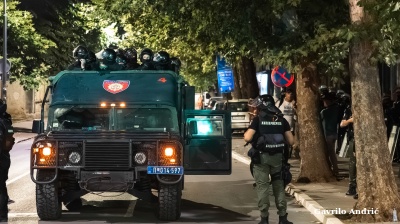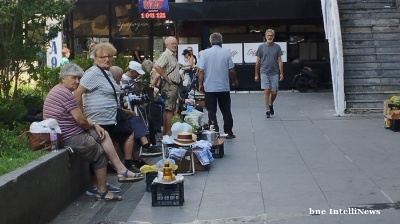Saudi Arabia-based power company ACWA Power plunges head first into Uzbekistan's green energy sector

Saudi Arabia-based utility developer ACWA Power plunged headfirst into the Uzbekistan green energy market. Since making its first investment in 2020 with a 1,500-MW plant in the ancient Silk Road city of Bukhara, it has built a string of projects across the country, investing more than $15bn with plans to invest another $5-6bn in the short term and take that to $25bn by the end of the decade.
“There has been a tsunami of investment projects into green energy in Uzbekistan,” Abid Malik, president, Central Asia, ACWA Power, told bne IntelliNews in an exclusive interview on the sidelines of the recent Tashkent International Investment Forum (TIIF) in June.
The pump was primed after the Uzbek government went after the UAE’s green energy leader Masdar, which has also invested billions into Uzbek green power. However, ACWA came on its own and has quickly caught up with Masdar and the two companies dominate the sector. ACWA has built power plants in Tashkent, Bukhara and Samarkand, and most recently is building its latest in Karakalpakstan in the far west of the country that has been designated a “green energy zone” to boost its development. The company has also recently signed new agreements for gas-fired power projects as part of its growing presence in Central Asia.
In August 2023, President Shavkat Mirziyoyev signed a decree establishing Karakalpakstan as a priority region for renewable energy development, focusing particularly on solar and wind power projects. The initiative includes tax incentives, customs exemptions and streamlined regulatory procedures aimed at encouraging both domestic and international investors. Both ACWA and Masdar have launched large solar and wind projects in the desiccated region.
After its initial hesitation, Uzbekistan has thrown itself into renewable energy sources and become the green energy champion of Central Asia. Having initially planned to have 25% of its energy mix from clean sources, Tashkent has now raised that target to 40%, according to the government’s development strategy to 2030. Many other emerging markets have followed suit after tumbling prices have now made renewables the cheapest source of power on the market and they come free of any transport, production or geopolitical problems.
Uzbekistan’s President Shavkat Mirziyoyev signed more agreements during a trip to Saudi Arabia last June, where he met Crown Prince Mohammed bin Salman (MbS) and other senior Saudi officials to discuss expanding bilateral cooperation, particularly in energy, investment and infrastructure. The trip also included the signing of several agreements with Saudi companies, notably with ACWA Power for new renewable and gas-fired energy projects in Uzbekistan.
The latest agreements include the development of two solar power plants with a combined capacity of 1,400 MW, alongside battery energy storage systems totalling 1,500 MW – a more recent add on to its various projects. The company will also build a 1,500-MW combined-cycle gas turbine (CCGT) plant in the Tashkent region, aimed at providing baseload power to support industrial growth in the capital. The latest initiatives will increase ACWA Power’s total capacity in the country to over 8,000 MW, according to company data.
The government has attracted foreign investment through regulatory reforms and public-private partnerships, with support from multilateral institutions including the World Bank and the Asian Development Bank (ADB).
Energy Minister Jurabek Mirzamakhmudov said ACWA Power’s projects would play a critical role in achieving national targets. “These investments are not only about energy security, but also about technology transfer, job creation and long-term strategic partnership,” he said.
The solar and gas projects are expected to begin construction in early 2026 and be operational by 2028.
Committed to the long term
To attract investors the government has offered guaranteed tariffs on a “take and pay” basis with 25 years duration. While the cost of green power has not been revealed, Malik says it is cheaper than gas and profitable for the investors.
“It’s a good deal for the government as they only pay for what they take. If the wind doesn’t blow or the sun doesn’t shine they don't have pay – we take the risk,” says Malik.
Increasingly ACWA has started adding battery storage to its generating capacity (China supplies the batteries) primarily to smooth out the production and better synchronise with the grid.
“We have installed battery storage to protect against acts of God,” says Malik. “There is now a large balance of storage that can supply some two hours of power if the generation production fluctuates too much.”
Batteries are an increasingly important part of ACWA’s projects. They were not featured in the company’s first project in Bukhara but included in the most recent projects in Samarkand (600 MW) and Karakalpakstan (1,000 MW).
“It’s become possible as the price of battery storage has fallen to a quarter of its 2012 levels from about €254 per megawatt hour to around €30-€40 now,” says Malik.
As ACWA is in it for the long term, the company has set up production for many of the inputs it needs. For the new Karakalpakstan project it is producing the towers and blades for the wind-powered plants in the region at a new facility built by ACWA.
“We at ACWA Power encourage as much local content as possible,” says Malik. “We have been enhancing the manufacturing capacity in the country as it also adds to the human capital, jobs and GDP for the country. We manufacture the turbines here and the blades are being made in Karakalpak where we are developing a 1,000-MW plant.”
But a lot more investment is still needed. In the old days power generation capacity was typically built where it was needed – close to cities or industry. With green typically the best locations are remote so the power they generate has to be transported over long distances.
“The biggest problem remains the transmission lines,” says Malik. “Forty years ago you would build a gas fired plant near the city you want to power. Today you want to build the green generating capacity where the sun shines hottest or the wind blows hardest. Then you have to get your power from these remote locations to where it is needed.”
Features

South Korea, the US come together on nuclear deals
South Korean and US companies have signed agreements to advance nuclear energy projects, aiming to meet rising data centre power demands, support AI growth, and strengthen the US nuclear fuel supply chain.

World Bank seems to be having second thoughts about Tajikistan’s Rogun Dam
Ball now in Dushanbe’s court to justify high cost.

INTERVIEW: From cinema to Serbian police cell in one unlucky “take”
An Italian software engineer caught in Belgrade’s August protests recounts a night of mistaken arrest and police violence in the city’s tense political climate.
_Cropped_1756210594.jpg)
Turkey breaks ground on its section of the TRIPP rail corridor
Turkish project would help make TRIPP the go-to route for Middle Corridor freight.

